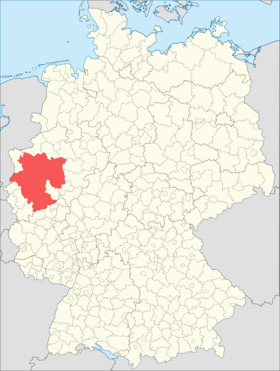
Back راين-رور Arabic Wawengkon métropolitan Rhine-Ruhr BAN Rin-Ruhr Catalan Metropolitní oblast Rýn-Rúr Czech Metropolregion Rhein-Ruhr German Metropola regiono Rejno-Ruhr Esperanto Rin-Ruhr Spanish Reini hiidlinnastu Estonian منطقه کلانشهری راین-رور Persian Rein–Ruhr Finnish
Rhine-Ruhr metropolitan region
Metropolregion Rhein-Ruhr | |
|---|---|
| |
 The Rhine-Ruhr metropolitan region of Germany | |
| Coordinates: 51°27′N 6°53′E / 51.450°N 6.883°E | |
| Country | |
| State | |
| Largest cities | Cologne Düsseldorf Dortmund Essen Duisburg Bochum Wuppertal Bonn |
| Area | |
| • Metro | 7,110 km2 (2,750 sq mi) |
| Highest elevation | 494 m (1,621 ft) |
| Lowest elevation | 20 m (70 ft) |
| Population (2021) | |
| • Metro | 11,300,000 |
| • Metro density | 1,600/km2 (4,100/sq mi) |
| GDP | |
| • Metro | €536.431 billion (2021) |
| Time zone | UTC+1 (CET) |
The Rhine-Ruhr metropolitan region (German: Metropolregion Rhein-Ruhr) is the largest metropolitan region in Germany, with over ten million inhabitants.[2] A polycentric conurbation with several major urban concentrations, the region covers an area of 7,110 square kilometres (2,750 sq mi), entirely within the federal state of North Rhine-Westphalia. The Rhine-Ruhr metropolitan region spreads from the Ruhr area (Dortmund-Bochum-Essen-Duisburg) in the north to the urban areas of the cities of Mönchengladbach, Düsseldorf (the state capital), Wuppertal, Leverkusen, Cologne (the region's largest and Germany's fourth largest city), and Bonn in the south. The location of the Rhine-Ruhr at the heart of the European Blue Banana makes it well connected to other major European cities and metropolitan areas such as the Randstad, the Flemish Diamond and the Frankfurt Rhine Main Region.
The metropolitan area is named after the Rhine and Ruhr rivers, which are the region's defining geographical features and historically its economic backbone.
- ^ "Bruttoinlandsprodukt (BIP) in den Metropolregionen* in Deutschland im Jahr 2021" (in German).
- ^ Öffentlichkeitsarbeit", IT.NRW - Zentralbereich 14 "Marketing und. "Information und Technik Nordrhein-Westfalen (IT.NRW) - Bevölkerungszahlen auf Basis des Zensus vom 9. Mai 2011". www.it.nrw.de (in German). Archived from the original on 2016-07-14. Retrieved 2018-03-25.
{{cite web}}: CS1 maint: numeric names: authors list (link)



